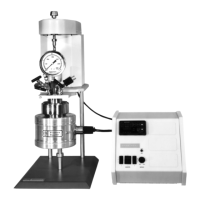- 5 -
4560 Mini Bench Top Reactors
Parr Instrument Company
Revision 6-28-02
INSTALLATION
Pressure and Temperature Limits
Working pressures up to 3000 psig
(207 bar) maximum are permissible in these
Mini Reactors when constructed of Type 316
Stainless Steel and equipped with a
magnetic stirrer drive. For reactors with a
packed gland instead of a magnetic drive,
the maximum pressure limit is reduced to
2000 psig (138 bar). Pressure limits for
reactors made of materials other than Type
316 Stainless Steel can be estimated as
described in Operating Instruction No.
230M. No attempt should be made to
increase these limits by making alterations
or by substituting components which are not
recommended by Parr Instrument Company.
It must also be understood that lower
pressure and temperature limits may be
required for modified reactors and for
vessels made of special alloys not listed in
Operating Instruction No. 230M. Limits for
such vessels will be determined by the
physical characteristics of the material of
construction and will be prescribed on an
individual basis.
Working temperatures up to 350 !C
are permissible in Mini Reactors equipped
with a standard, flat gasket, No. 457HC2,
made of PTFE fluoropolymer resin. A PTFE
gasket is the recommended choice for most
applications since the PTFE resin is inert to
most chemicals and it will provide good
seals under repeated opening and closing if
the gasket temperature does not exceed
350 !C. The service life of a PTFE gasket
will, however, be reduced considerably if
used at temperatures above 300 !C. For
better service in the 300 !C to 350 !C
operating range Parr recommends a flexible
graphite gasket, No. 457HC3KL.
The maximum working pressure and
temperature for any vessel is governed by
the design of the vessel and the strength of
the material from which it is constructed.
There is also a close relationship between
working pressure and temperature since the
strength of any material will normally fall off
as the temperature is increased.
Temperature and pressure limits are also
affected by the physical properties and
temperature limits of the gaskets and seals
used in the vessel, and by any valves,
gages or other fittings attached to the
vessel. Obviously, the safe operating
pressure of any system can be no higher
than that of its lowest rated component.
Working temperatures up to 225 !C
are permissible in mini reactors equipped
with fluoroelastomer (FKM) O-ring seals.
The higher the operating temperature above
200 !C, the shorter the life of the O-ring will
be. Perfluoroelastomer (FFKM) O-ring seals
have a broad chemical resistance and can
be used to temperatures up to 300 !C.
Unfortunately they are very expensive and
will generally be reserved for unique
applications. Ethylene-propylene (EP)
O-rings can be used to 170 !C and are
recommended for applications such as
ethers, ammonia and amines which will
rapidly destroy fluoroelastomer O-rings.
The working pressure and
temperature in these 100 mL thru 600 mL
reactors must not exceed the following
maximum limits:
Pressure and Temperature Limits
Bomb
Material
Maximum
Pressure
Maximum
Temperature
T316 SS 3000 psig
350! PTFE Flat
Gasket
T316SS 3000 psig
225! FKM O-Ring
T316SS 3000 psig
300! FFKM O-Ring

